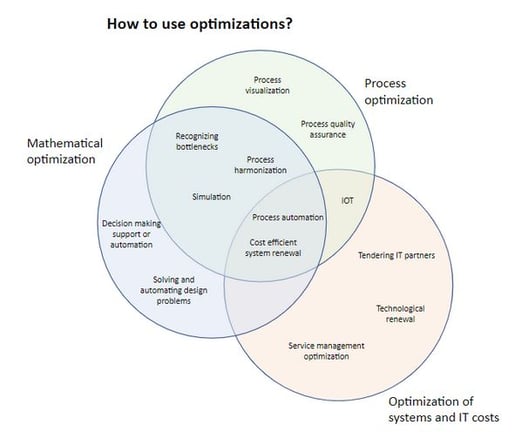Optimization is a very general term and it can mean many things. On a daily basis we talk about process optimization, systems optimization, IT cost optimization, mathematical optimization, and not to mention that if you Google search the term it produces a huge number of links; even at the level of optimizing a car’s performance. All of these are needed, but how can one choose the right optimization method/solution that will help one’s particular business?
The answer may not be as unambiguous as you think; depending on the goal and target, you may have to use several methods. I’ll try to help you get started by opening up the background and purpose of different optimizations. Although I can't take a stand on optimizing the power of cars, I will leave that to skilled car mechanics.
Mathematical optimization
Mathematical optimization is used to find the best or most optimal result among an innumerable set of different possible options. It allows you to solve a variety of design problems, such as complex logistics, resourcing, placement, and balancing problems. Here, the resource can be a human or just as well a limited resource related to the production process.
For example, mathematical optimization tells you in what order things need to be done, who or what needs to do the work, and when or how the pieces need to be composed to get the best outcome, to meet your goals. It can also answer the question of what is the optimal order batch, considering sales and inventory size.
Mathematical modeling and optimization can also be used to model processes and simulate them with different input data. In this case, the mathematical model serves as a tactical level planning tool in the type of ‘Digital Twin’ (is a virtual representation that serves as the real-time digital counterpart of a physical object or process) and can be used for example to identify future bottlenecks or direct investments.
Our partner Gurobi has conducted a study on the use of business optimization. According to the study, companies use optimization for the following purposes:
- 57.9% to maximize resource utilization
- 53.4% to maximize profits
- 42.7% to maximize revenue
- 28.7% to reduce delays
- 24.7% to reduce waste
- 19.1% to reduce downtime
Using mathematical optimization requires special expertise in mathematical modeling, operations research, analytics, and programming.
Process optimization
There are several ways and tools for describing and modeling processes. These tools help to visualize and understand the flow of processes. With the help of visualization, experience and, for example, the ‘Lean’ method, bottlenecks are identified and process development needs identified. In this case, process optimization is based on experience, methods, and common sense.
You need process optimization and descriptions in the following situations:
- Quality assurance and guidance
- Process visualization
- Sharing information about the operation of the process
- Risk management
- Process management
Process optimization is often concerned with the automation of industrial processes, in which case, for example, process-related starts, breaks, type changes and on-going process management are automated as far as possible.
Process optimization requires process expertise, knowledge of the latest technological developments, a systematic approach and perseverance.
Optimization of systems and IT costs
In many companies, it is also topical to optimize systems and IT costs. This is particularly pronounced in digital industries, where a company’s costs consist mainly of staff and IT costs.
When starting to optimize IT costs, investigations into these costs are made. How much is used to new development and maintenance, which include both infrastructure and application costs.
During the work, the utilization rates of the systems are reviewed and systems' roles on the system map are examined. It is essential to find out the overlaps in the system map, and whether, for example, a non cost-effective and expensive system can be abandoned by replacing or archiving it. Or whether there is a major unfinished core system replacement project and the old system still incurs costs because some small but important functionality has not been built to the new system.
The cost of the remaining systems can be optimized by rationalizing service management costs. There are several ways to do it, for example, you can move to scalable cloud services infrastructure but remember that the greatest benefits will only be obtained when application development environments and working methods are also renewed.
Costs can also be optimized by eliminating unnecessary duplication of servers or by servicing and tendering data center services. The cost of application management can be optimized by bundling and bidding for suitable entities so that the cost of service management can be reduced.
You need systems optimization when:
- IT costs seem to be getting out of hand
- You want to allocate more budget for IT development
- You want to improve the reliability of the systems
- The overall picture of the systems used in the company is incomplete

Should I use one or several optimizations?
As can be seen from the previous examples, optimization can be used in many ways and each has its own role when improving a company's efficiency. On the other hand, it is recognizable that by combining different optimizations and a model of continuous improvement, significant competitive advantages can be achieved.
For example, in the manufacturing industry, the benefits of process optimization and mathematical optimization can be combined to refine process start-up and functionalities switching, and mathematical optimization to design, such as the optimal run order for different products or an optimal phasing or product testing plan.
As they say, “a rolling stone gathers no moss” so to be able to stay competitive, it’s good to be aware of all the different optimizations and make sure the company uses them all effectively and keeps developing.
Could we boost your business through optimization?
Read more about our optimization current state assessment.
